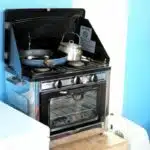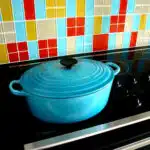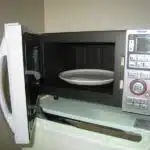Steam cleaning an oven is a crucial aspect of maintaining its efficiency and prolonging its lifespan. Steam cleaning is the process of using hot water vapor to eliminate dirt, grime, and grease from the surface of the oven without using any chemicals or harsh cleaners. It’s an eco-friendly way of cleaning your oven that also ensures it stays in good working condition.
As an expert in oven cleaning, I understand the importance of keeping your kitchen appliances clean and functional. A dirty and greasy oven can affect the taste and quality of your food, increase energy consumption, and even cause fire hazards. Therefore, it’s essential to regularly steam clean your oven to maintain its performance and ensure a safe cooking environment. In this article, we will discuss how to steam clean an oven effectively while avoiding common mistakes that could damage your appliance.
Understanding The Importance Of Oven Maintenance
Oven maintenance is a crucial aspect of keeping your kitchen running smoothly. Neglecting your oven’s upkeep can lead to expensive repairs and even pose a safety hazard. The importance of regular oven maintenance cannot be overstated, and one of the best ways to keep your oven in top-notch condition is through steam cleaning.
Steam cleaning has become increasingly popular as an effective means of cleaning ovens. This method uses high-temperature steam to remove grime and grease from the oven walls, racks, and doors. One of the benefits of steam cleaning is that it does not require harsh chemicals or scrubbing, making it an eco-friendly option for those concerned about their carbon footprint.
Another advantage of steam cleaning is that it sanitizes the oven, killing germs and bacteria that may be lurking inside. This is especially important if you use your oven frequently to cook meat or poultry. Regularly steam cleaning your oven will help prevent cross-contamination and ensure that your food is safe to eat. By understanding the importance of regular oven maintenance and the benefits of steam cleaning, you can keep your kitchen safe, clean, and efficient.
Transition: Now that you understand why steam cleaning is so important for maintaining an oven’s health, let’s move on to preparing your appliance for this process.
Preparing Your Oven For Steam Cleaning
Ah, the joys of oven cleaning. The task we all love to hate and avoid doing at all costs. But fear not, my fellow cleaning enthusiasts, for there is a better way – steam cleaning! Before you jump right in, let’s go over some pre-steam cleaning precautions to ensure a safe and effective clean.
Firstly, make sure that your oven is cool to the touch before starting the steam cleaning process. Attempting to clean a hot oven can be dangerous and may cause injury. Also, remove any loose debris or food particles from inside the oven using a damp cloth or vacuum cleaner. This will help prevent any unwanted smells or smoke during the steaming process.
So how often should you steam clean your oven? It really depends on how frequently you use it. For those who cook regularly, it is recommended to steam clean once every three months. However, if you’re more of an occasional cook, then once every six months should suffice.
Now that we’ve covered some pre-cleaning precautions and frequency guidelines, it’s time to gather the necessary tools and equipment for our steam cleaning adventure.
Gather The Necessary Tools And Equipment
Before you begin the process of steam cleaning your oven, it’s important to gather all the necessary tools and equipment. The first thing you’ll need is a steam cleaner. There are a few different types of steam cleaners on the market, each with its own set of benefits and drawbacks. One option is a handheld steamer, which is great for smaller ovens or hard-to-reach areas. Another option is a canister-style steam cleaner, which has a larger capacity and more powerful steam output.
In addition to the steam cleaner itself, you’ll also need some other tools to help with the cleaning process. A scraper tool can be useful for removing any large pieces of debris or food residue from the oven interior. You’ll also want to have some microfiber cloths on hand for wiping down surfaces and absorbing excess moisture. Finally, make sure you have some protective gear like gloves and goggles to keep your hands and eyes safe during the cleaning process.
The benefits of steam cleaning an oven are numerous. Not only does it provide a deep clean that can remove even stubborn stains and grime, but it’s also an eco-friendly option that doesn’t require harsh chemicals or fumes. Additionally, steam cleaning can help kill off bacteria and germs that may be lurking in your oven, leaving it not only looking great but also safer for cooking food in. With the right tools and equipment, anyone can tackle this task with ease!
Moving forward into the next section about removing loose debris and food residue, start by using your scraper tool to gently scrape away any large pieces of debris from inside the oven cavity. Be careful not to scratch any surfaces with this tool! Then use your microfiber cloth dampened with water to wipe away any remaining residue or grease buildup from all surfaces inside the oven.
Removing Loose Debris And Food Residue
One of the most important steps in steam cleaning an oven is removing loose debris and food residue. This not only ensures an effective cleaning process but also prevents any potential hazards during the steaming process. For instance, if there are food particles or debris left inside the oven, they could catch fire or produce unpleasant odors while being steamed.
To remove loose debris and food residue from your oven, you will need a few tools. A scraper can be handy for removing any hardened or stubborn debris. Additionally, a soft-bristled brush can help loosen up food particles that are stuck to the walls of your oven. It’s crucial to use these tools carefully to avoid damaging the interior of your oven.
Effective cleaning methods vary depending on the type of oven you have and how dirty it is. For light cleaning, wiping down your oven with a damp cloth could suffice. However, for more significant build-up, you may need to use stronger cleaning agents like vinegar or baking soda mixed with water. The key is to apply these methods gently and avoid using harsh chemicals that could damage your oven’s surface.
Removing loose debris and food residue is just one step towards achieving a sparkling clean oven through steam cleaning. The next section will discuss choosing the right type of water for optimal results.
Choosing The Right Type Of Water For Steam Cleaning
- Purified water is essential for steam cleaning an oven as it ensures that no minerals or other impurities are present that could damage the oven or leave behind a residue.
- The mineral content of the water used for steam cleaning should also be taken into consideration as certain minerals can corrode the oven’s surfaces.
- Additionally, the water’s hardness level should be considered when selecting water for steam cleaning an oven.
- Hard water contains more calcium and magnesium, which can cause limescale deposits to build up on the oven’s surfaces.
- Soft water is typically preferred for steam cleaning an oven due to its low mineral content, however, it is typically more expensive than hard water.
- Using the wrong type of water for steam cleaning an oven can result in costly repairs or replacements, so it is important to research the best type of water for your specific oven model.
Purified Water
As an oven cleaning expert, I know that choosing the right type of water for steam cleaning is crucial to ensure optimum performance and efficiency. When it comes to purified water, there are different types available in the market, each with its own set of advantages and disadvantages. Understanding the differences between them can help you make an informed decision on which type of purified water to use for your oven.
One advantage of using purified water for steam cleaning is that it removes impurities and contaminants from the water, which can prolong the lifespan of your oven and prevent corrosion or damage to its components. There are different types of purified water, including distilled, deionized, reverse osmosis (RO) and carbon-filtered water. Distilled water is boiled and condensed back into liquid form to remove all impurities while deionized water has undergone a process that removes both minerals and ions from the water. RO purified water uses a membrane filtration system while carbon-filtered water passes through activated carbon filters to remove impurities.
While each type of purified water has its own benefits, it’s important to note that not all types may be suitable for steam cleaning depending on your specific needs. As an expert in oven cleaning, my recommendation would be to consult with a professional or refer to manufacturer’s guidelines before choosing a specific type of purified water for your oven. By doing so, you can ensure that you are using the appropriate type of purified water for effective steam cleaning without compromising the safety or quality of your oven.
Mineral Content
When it comes to choosing the right type of water for steam cleaning, it’s important to consider the mineral content. Hard water stains and mineral buildup can be tough to remove and may even damage your oven if not properly addressed. Purified water is often recommended for steam cleaning as it removes impurities that can cause these issues.
One type of purified water that is particularly effective in preventing mineral buildup is deionized water. This type of purified water has had all minerals and ions removed, leaving behind only pure H2O molecules. Deionized water is often used in industrial applications where mineral-free water is necessary. Using deionized water for steam cleaning can help prevent mineral buildup, which can prolong the lifespan of your oven and keep it looking clean and new.
In addition to preventing mineral buildup, using purified water for steam cleaning can also help remove hard water stains. Distilled or reverse osmosis (RO) purified water are two types that are particularly effective at removing these stubborn stains. Both methods remove impurities from the water, leaving behind only pure H2O molecules. By using distilled or RO purified water for steam cleaning, you can ensure that your oven stays free of hard water stains and looks its best for years to come.
Hardness Level
Understanding water hardness is essential when it comes to choosing the right type of water for steam cleaning your oven. Hardness level refers to the amount of dissolved minerals, such as calcium and magnesium, present in the water. These minerals can leave white spots or streaks on surfaces after cleaning, which is why it’s important to choose the right steam cleaner for your oven.
If you have hard water, using a steam cleaner with a built-in water softener is recommended. This will help remove minerals from the water before it’s used for cleaning. Another option is to use a descaling solution along with purified or distilled water to prevent mineral buildup and keep your oven looking clean and new.
In addition to preventing mineral buildup, understanding water hardness can also help you choose the right type of steam cleaner for your oven. If you have extremely hard water, a high-pressure steam cleaner may be necessary to effectively remove tough stains and grime. On the other hand, if you have softer water, a lower-pressure steam cleaner may be sufficient for regular maintenance cleaning. By understanding water hardness and choosing the right steam cleaner for your oven, you can ensure that it stays clean and in good condition for years to come.
Filling The Steam Cleaner With Water
To begin the steam cleaning process, it is crucial to fill the steam cleaner with water. Before filling the tank, ensure that the appliance is unplugged and cooled down. Most steam cleaners have a removable water tank that can be filled directly from a faucet or using a separate container.
When filling the steam cleaner, it is essential to use distilled or demineralized water instead of tap water. Tap water contains minerals that can clog up the system and reduce its effectiveness over time. The quality of water also affects the lifespan of the cleaning product and prevents damage to its heating elements.
Once you have filled the steam cleaner with distilled or demineralized water, ensure that you follow the manufacturer’s instructions on setting temperature and time for steam cleaning. This will help you achieve optimal results while avoiding potential damages to your oven. Additionally, it is crucial to adjust the water temperature settings according to your oven’s requirements, as different ovens may require different levels of heat intensity for efficient cleaning.
Setting The Temperature And Time For Steam Cleaning
- Steam cleaning an oven requires careful consideration of both temperature and timer settings.
- The temperature of steam cleaning should be set to the highest temperature recommended by the manufacturer.
- Setting the timer depends on the type of oven being steam cleaned, as well as the amount of buildup present.
- When steam cleaning a new oven, the timer should be set to the minimum recommended time.
- Estimating the time needed for steam cleaning an oven can be done by observing the amount of buildup present.
- Generally, the more buildup present, the longer the steam cleaning process should be allowed to continue.
Setting Temperature
Setting the temperature is a crucial part of steam cleaning an oven. Choosing the right temperature ensures that the steam penetrates every nook and cranny of the oven, effectively removing all grease, grime, and food residue. As an oven cleaning expert, I highly recommend adjusting the temperature according to the manufacturer’s instructions. Generally, most ovens require a temperature range between 250°F to 300°F for optimal cleaning results.
Apart from choosing the right temperature, adjusting duration is equally important. The duration should be set based on how dirty your oven is and how long it has been since you last cleaned it. A heavily soiled oven will require a longer steaming time than one that has been regularly cleaned. In general, a duration of 30 minutes to an hour is sufficient for most ovens.
It’s worth noting that setting the temperature too high can damage your oven’s interior or cause damage to its heating elements. Therefore, as an expert in this field, I advise against using temperatures above 350°F when steam cleaning your oven. By following these guidelines on setting the appropriate temperature and duration for steam cleaning your oven, you’ll achieve a sparkling clean result without any damages or issues along the way.
Setting Timer
To achieve a thorough cleaning of your oven, setting the temperature and duration are essential factors to consider. However, it’s equally important to set the timer correctly to avoid oversteaming or understeaming your oven. As an expert in this field, I would like to share some tips on how to set the timer for steam cleaning.
Firstly, it’s recommended to follow the manufacturer’s instructions when setting the timer. The duration for steam cleaning should be based on the level of dirtiness of your oven and how long it has been since you last cleaned it. A heavily soiled oven may require a longer steaming time compared to one that has been regularly maintained. Therefore, take note of these factors before setting the timer.
Another benefit of setting the timer is that it allows you to monitor the progress of your oven’s cleaning process. You can check on your oven periodically during the steaming process to ensure that everything is going according to plan. If you notice any issues such as oversteaming or understeaming, you can adjust the timer accordingly. By doing so, you’ll achieve optimal results without damaging your oven’s interior or heating elements.
Estimating Time Needed
One of the most important factors to consider when steam cleaning your oven is estimating the time needed for the process. This requires a keen understanding of the level of dirtiness in your oven, as well as its overall efficiency. An expert in oven cleaning should be able to gauge how long it will take to achieve optimal results without damaging any components.
Estimating efficiency involves taking into account various factors such as the type of oven, its age, and how often it’s been cleaned in the past. A newer oven that has been regularly maintained will require less steaming time compared to an older one that hasn’t been cleaned in months. By assessing these factors, you can determine how much time is needed for a thorough clean without oversteaming or understeaming.
Monitoring progress is another crucial aspect of setting the timer for steam cleaning. This allows you to check on your oven periodically and make adjustments if necessary. By doing so, you can ensure that everything is going according to plan and avoid any mishaps during the process. As an expert in this field, I highly recommend taking a hands-on approach when steam cleaning your oven and being mindful of how much time is needed for optimal results.
Starting The Steam Cleaning Process
After setting the temperature and time for steam cleaning, it is time to prepare the oven for steam cleaning. Using a steam cleaner is an efficient and eco-friendly way to clean your oven without using harsh chemicals. Before beginning the process, start by removing all racks, trays, and other accessories from the oven.
Once you have removed all items from inside the oven, wipe down any loose debris with a damp cloth or sponge. It is important to remove as much debris as possible before starting the steam cleaning process. This will ensure that any dirt or grime left behind will be loosened by the steam.
Next, fill your steam cleaner with water according to its instructions and attach any necessary attachments. Once it is ready to use, begin steaming your oven’s interior thoroughly. Be sure to hit all corners and crevices of the oven so that no area is missed. After completing this step, move on to wiping down both the interior and exterior of the oven for a thorough clean.
Wiping Down The Interior And Exterior Of The Oven
Wiping down the interior and exterior of your oven is an important step in maintaining its cleanliness. After steaming, use a damp cloth to wipe away any loosened debris or grime. This will ensure that any remaining stains or dirt are removed, leaving your oven looking spotless.
One of the benefits of steam cleaning an oven is that it can help remove tough stains and grease buildup. However, for particularly stubborn stains, you may need to use a cleaning solution. It’s important to choose the best cleaning solution for your particular oven type and the type of stain you’re dealing with. For example, if you have a self-cleaning oven, you should avoid using harsh chemicals as they can damage the interior coating.
When wiping down the exterior of your oven, be sure to focus on areas like the door handle and control panel which can accumulate dirt and grime over time. Use a gentle cleaner or mild soap and water to clean these areas thoroughly. Once you’ve finished wiping down both the interior and exterior of your oven, it’s time to move on to cleaning the oven racks.
Transition: Now that we’ve discussed how to wipe down the interior and exterior of your oven after steam cleaning, let’s move on to tackling those dirty oven racks.
Cleaning The Oven Racks
After wiping down the interior and exterior of your oven, it’s time to move onto cleaning the oven racks. These racks can become incredibly dirty with baked-on grease and food residue, so it’s important to give them a thorough clean every now and then. To begin, remove the racks from your oven and place them in your sink or bathtub.
Cleaning solution alternatives can be used for this process. One popular method is using a mixture of baking soda and water. Simply mix together equal parts baking soda and water until it forms a paste. Spread this paste over the oven racks and let it sit for about 15-20 minutes before scrubbing with a brush or sponge. Rinse thoroughly with water and dry completely before returning the clean racks back into your oven.
Preventing future grime on your oven racks can help make cleaning them easier in the future. Consider using silicone mats or parchment paper when cooking to prevent spills or drips from sticking directly onto the rack. You can also try placing a sheet of aluminum foil underneath any particularly messy dishes to catch any drips before they have a chance to harden onto your oven rack.
Dealing with stubborn stains and grease buildup on your oven may require more than just wiping down and cleaning the racks. In these instances, you may need to invest in stronger cleaning solutions or seek professional help if necessary. But by taking preventative measures such as regularly wiping down your oven after each use, you can avoid having to deal with stubborn stains altogether.
Dealing With Stubborn Stains And Grease Buildup
Scraping grease from an oven requires a metal spatula or scraper to be used with caution to avoid damaging the oven’s interior. Soaking stains in the oven can be done with a mixture of baking soda and white vinegar for a few hours to loosen them for easier removal. Natural cleaners such as lemon juice and baking soda can be used to safely and efficiently remove grease and grime from the oven’s interior.
Scraping Grease
As an oven cleaning expert, I know that scraping grease is a crucial step in dealing with stubborn stains and grease buildup. Preventing grease from accumulating in the first place is ideal, but if it has already built up, you’ll need to use some effective cleaning techniques.
One of the simplest ways to remove grease is by using a plastic scraper. It’s especially useful for removing large pieces of burnt-on food or residue. Start by allowing your oven to cool down completely before scraping away any hardened drips or spills. Be gentle when scraping to avoid damaging the surface of your oven.
Another technique is by making a paste using baking soda and water. Spread this mixture over the greasy areas and let it sit for about 15-20 minutes before scrubbing with a sponge or soft-bristled brush. Baking soda helps loosen stubborn grease while also neutralizing unpleasant odors.
By applying these techniques, you can effectively get rid of stubborn stains and prevent future buildup. Remember to always follow the manufacturer’s instructions when cleaning your oven and wear protective gloves and goggles for safety purposes.
Soaking Stains
When it comes to dealing with stubborn stains and grease buildup in your oven, pre-treating the stains is a crucial step. Soaking is one of the best methods for pre-treating tough stains and grease buildup. As an oven cleaning expert, I highly recommend soaking as a natural and effective way to loosen up stubborn grime before scrubbing.
To soak your oven, you’ll need a natural cleaning solution such as white vinegar or lemon juice. Dilute the vinegar or lemon juice with water and pour it into a spray bottle. Spray this solution over the greasy areas of your oven and let it sit for at least 30 minutes to an hour. The acidity in these solutions helps break down the grease while also disinfecting your oven.
After soaking, use a sponge or soft-bristled brush to scrub away the loosened grime. You can also use a plastic scraper to remove any remaining residue gently. Remember always to avoid using abrasive tools that could scratch or damage your oven’s surface.
By incorporating soaking into your regular cleaning routine, you can effectively eliminate stubborn stains and prevent future buildup without damaging your oven’s surface. Always remember to wear protective gloves and goggles when handling cleaning solutions, especially if you have sensitive skin or allergies.
Natural Cleaners
When it comes to tackling stubborn stains and grease buildup in your oven, there are many cleaning solutions available on the market. However, as an oven cleaning expert, I highly recommend using natural cleaners over chemical ones. Natural cleaners have several benefits such as being eco-friendly and safe for your family and pets. Unlike chemical cleaners that contain harmful ingredients that can damage your oven’s surface and emit harmful fumes, natural cleaners are gentle yet effective.
One of the most popular natural cleaners for removing stubborn stains and grease buildup is baking soda. Baking soda is a versatile ingredient that can be used in various ways to clean your oven. To use baking soda as a cleaner, mix it with water until it forms a paste-like consistency. Apply the mixture to the affected areas of your oven and let it sit for at least 30 minutes before wiping away with a damp cloth or sponge. Baking soda is also an effective deodorizer that can eliminate any unpleasant odors in your oven.
Another excellent natural cleaner is hydrogen peroxide. Hydrogen peroxide is a powerful oxidizer that can break down even the toughest stains and grease buildup in your oven. To use hydrogen peroxide as a cleaner, mix it with water in equal parts and spray it over the affected areas of your oven. Let it sit for at least 30 minutes before wiping away with a damp cloth or sponge. Hydrogen peroxide can also help brighten up dull surfaces and make them look like new again.
In summary, natural cleaners are an excellent choice for dealing with stubborn stains and grease buildup in your oven compared to chemical cleaners due to their eco-friendliness and safety factors. Baking soda and hydrogen peroxide are two of the most popular natural cleaners you can use on your oven, but there are many other options available if you prefer something else. By incorporating natural cleaners into your regular cleaning routine, you can effectively eliminate tough grime without damaging your oven’s surface.
Avoiding Common Mistakes When Steam Cleaning
It is important to be mindful of the common steam cleaning mistakes when cleaning your oven with steam. One of the most common mistakes is leaving the door open during the process. This can cause damage to both the door and surrounding areas, as well as decrease the effectiveness of the steam cleaning process. It is vital to keep the oven door closed while steaming.
Another mistake that many people make when steam cleaning their oven is using too much water. While it may seem like adding more water will increase the effectiveness of the steam, it can actually damage your oven by causing rusting or warping. It is best to use a moderate amount of water and follow the manufacturer’s instructions for your specific model.
To avoid damaging your oven during steam cleaning, there are a few tips to keep in mind. Always use distilled water, as tap water may contain minerals that can cause buildup and harm your oven’s interior. Additionally, make sure to clean any excess moisture from inside your oven after completing the steam clean cycle. By following these simple tips, you can ensure that your oven remains in optimal condition even after using a powerful cleaning method such as steam.
When it comes to maintaining your oven’s cleanliness, there are several things you can do on a regular basis to prevent buildup and grime from accumulating over time. These tips include wiping down spills immediately after they occur, regularly wiping down the interior with a damp cloth, and periodically performing deep-cleaning cycles such as steam cleaning or self-cleaning modes (if available). By incorporating these practices into your routine maintenance schedule, you can keep your oven looking and functioning like new for years to come.
Tips For Maintaining Your Oven’s Cleanliness
Maintaining the cleanliness of your oven is essential to ensure that it functions correctly and lasts longer. Regular cleaning has numerous benefits, including preventing the buildup of grease and grime, reducing the chances of food contamination, and improving the overall performance of your oven. A clean oven also ensures that your food tastes better and does not have any residual odors.
One effective way to maintain your oven’s cleanliness is by using DIY cleaning solutions. These solutions are made from natural ingredients such as baking soda, vinegar, and lemon juice. They are cost-effective, easy to make, and safer to use than harsh chemicals found in commercial cleaning products. Additionally, they are gentle on your oven’s interior surface, ensuring that it remains in great condition for longer.
To keep your oven clean for longer periods between deep cleans, there are a few tips you can follow. One tip is to cover the base of your oven with aluminum foil or a non-stick liner to catch any spills or drips. You should also wipe down the door after each use with a damp cloth or sponge to prevent any buildup from occurring. Lastly, remember never to leave spills unattended for prolonged periods as this can cause stains that will be difficult to remove later.
Now that you understand the benefits of regular cleaning and how DIY solutions can help maintain your oven’s cleanliness let us focus on troubleshooting common problems that occur when using an oven.
Troubleshooting Common Oven Problems
- A faulty heating element may be the cause of an oven not heating up properly. Testing the element for continuity is a necessary step when troubleshooting this issue.
- An oven door issue could be caused by a broken latch or hinge. It is important to identify the cause of the problem before attempting to repair the oven door.
- Steam cleaning an oven is an efficient and chemical-free method to clean the interior of an oven.
- Before steam cleaning an oven, it is important to ensure that the oven is unplugged and that the heating elements have cooled down.
Faulty Heating Element
As an oven cleaning expert, I have encountered various oven problems that cause inconvenience to homeowners. One of the common issues that homeowners face is a faulty heating element. A heating element is responsible for generating heat in the oven to cook food evenly. However, when it breaks down or malfunctions, the oven may not cook food properly.
To troubleshoot this issue, you need to identify if the heating element is indeed faulty. Check if the element has any visible signs of damage or wear and tear. If so, you may need to replace the heating element. Before replacing, make sure to turn off the power supply and disconnect the wires connected to the heating element. Then, remove it from its position and replace it with a new one.
Another troubleshooting tip is to check if there are any loose connections or damaged wires that connect the heating element to other components of your oven. This can cause a disruption in power flow which results in insufficient heat generation from your oven’s heating elements.
In conclusion, a faulty heating element can be frustrating when using your oven for cooking meals. It’s essential to troubleshoot and fix this problem immediately by checking for visible signs of damage or wear and tear on your heating elements and wires connecting them together before replacing them if necessary. By following these simple tips, you can ensure that your oven works efficiently and cooks food evenly every time you use it!
Oven Door Issue
As an oven cleaning expert, it’s common for homeowners to encounter problems with their oven door. A damaged or faulty oven door can cause inconvenience and safety hazards when cooking meals. It’s essential to troubleshoot and fix this problem immediately by identifying the root cause of the issue.
One of the most common causes of a malfunctioning oven door is wear and tear, which can result in loose hinges or screws. To prevent this, it’s crucial to inspect your oven regularly and tighten any loose screws or hinges promptly. If you notice any visible damage or cracks on the door glass, replace it immediately to prevent further damage.
Another troubleshooting tip is to check if there are any obstructions that prevent your oven door from closing properly. This can be caused by food or debris buildup around the edges of the oven door. Clean these areas thoroughly using a damp cloth to ensure that your oven door closes smoothly without obstruction.
In conclusion, fixing an oven door issue is crucial for ensuring safe and efficient cooking in your kitchen. By regularly maintaining your oven’s components such as hinges, screws, and glass doors, you can prevent any potential damage that may affect its performance. Incorporating these tips into your routine maintenance will keep your family safe from accidents while cooking meals in your kitchen!
Conclusion: A Clean Oven For Safe And Delicious Cooking
Imagine the satisfaction of opening your oven door to reveal a spotless, shiny interior. No more burnt-on grease or food residues that could taint the taste or safety of your meals. A clean oven ensures not only delicious and healthy cooking but also the prevention of hazards such as fire and smoke. Therefore, it is essential to learn how to steam clean an oven.
Safety should always be a top priority in any kitchen. A dirty oven can harbor bacteria and germs that can cause illnesses or infections. Moreover, accumulated grime and debris can affect the performance of your oven by clogging vents or interfering with temperature regulation. By regularly steam cleaning your oven, you eliminate these risks and maintain optimal functionality.
Aside from safety concerns, there are many benefits to having a clean oven. A sparkling interior enhances the appearance of your kitchen and makes cooking more enjoyable by providing a fresh start for each culinary masterpiece. It also prolongs the lifespan of your appliance by preventing corrosion and damage caused by built-up dirt. Ultimately, investing time in steam cleaning your oven pays off in terms of improved hygiene, aesthetics, and longevity.
Conclusion
Maintaining a clean oven is essential for safe and delicious cooking. Steam cleaning offers an effective solution to remove stubborn stains and grime from your oven without the use of harsh chemicals. Before steam cleaning, it is important to prepare your oven by removing loose debris and food residue. You will also need to gather the necessary tools and equipment, including a steam cleaner.
When choosing the right type of water for steam cleaning, be sure to use distilled or demineralized water to prevent mineral buildup in your oven. Avoid common mistakes such as using too much water or leaving the oven door open during steaming. Regular maintenance of your oven will help prolong its lifespan and prevent costly repairs.
As an expert in oven cleaning, I strongly recommend that you troubleshoot common problems such as uneven heating or strange odors immediately before they worsen. Think of your oven as a car that requires regular tune-ups to perform at its best. A clean oven not only ensures safe cooking but also adds a touch of elegance to your kitchen.
In conclusion, maintaining a clean oven is crucial for safe and delicious cooking. Steam cleaning offers an eco-friendly solution that effectively removes stubborn stains and grime without harsh chemicals. Remember to prepare your oven adequately before steam cleaning, avoid common mistakes, choose the right type of water, maintain regularly, and troubleshoot common problems promptly. A well-maintained oven is like a reliable car that delivers excellent performance every time you use it!
Image Credits
- “How to Steam Clean Stove and OVen” by Carissa Marie (featured)





























